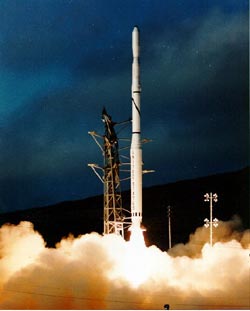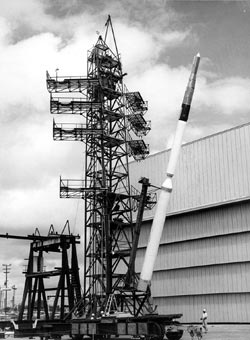|
 The SCOUT Launch Vehicle program was initiated in 1959 by the National Advisory Committee for Aeronautics (which later became the National Aeronautics and Space Administration [NASA]). The SCOUT Launch Vehicle program was initiated in 1959 by the National Advisory Committee for Aeronautics (which later became the National Aeronautics and Space Administration [NASA]).
The national goal was the launching of small scientific satellites into near earth orbit in an economical manner. Chance Vought Aircraft Corporation competed against eleven other aerospace companies and won the competition to become prime contractor.
The first launch occurred in mid-1960. The last launch, Number 118, took place on May 8, 1994. Those thirty-four years made SCOUT one of NASA’s most successful, longest running expendable launch vehicle programs. Chance Vought and its successors remained as prime contractor for the life of the SCOUT program.
As prime contractor, the company’s job was to develop vehicle structures and integrate four solid-rocket motors into a 70-foot, 35,000-pound launch vehicle designed for a variety of space tasks including orbital, high-altitude probe and high-speed reentry missions. The result was an economical vehicle that was to become a workhorse in the space programs of several nations, including Italy, Great Britain, Germany, France, The Netherlands and the multi-national European Space Research Organization.
 The first three years of development were fraught with obstacles as the engineers pushed the limits of technology. No one had ever built a vehicle with the capabilities demanded by NASA, and time was of the essence. After a variety of failures, an exhaustive certification program was initiated in 1963. After that, a success rate of 96 percent was attained for the remainder of the launches. The first three years of development were fraught with obstacles as the engineers pushed the limits of technology. No one had ever built a vehicle with the capabilities demanded by NASA, and time was of the essence. After a variety of failures, an exhaustive certification program was initiated in 1963. After that, a success rate of 96 percent was attained for the remainder of the launches.
SCOUT was launched from three different sites: NASA’s Wallops Flight Center, Wallops Island, VA. The Western Test Range at Vandenberg Air Force Base, California; and Italy’s unique sea-based San Marco platform off the east coast of Kenya, Africa, the site for nine successful equatorial missions beginning in 1967.
SCOUT capability grew dramatically over the years. Originally able to place a 131-pound payload in a nominal 300-mile orbit, SCOUT performance increased to allow payloads of up to 458 pounds. The load-carrying capability increased 350 percent over that of the original vehicle with little increase in the size of the rocket stages.
The value of the program to the company grew as well, from the initial $1 million contract to more than $350 million.
To commemorate SCOUT’s immense contribution to America’s space program, a SCOUT vehicle now stands proudly in the Smithsonian Institution’s Air and Space Museum in Washington, D.C.
SCOUT LAUNCH VEHICLE:
Motors and Structure
Flight Control
Sequencing the Flight Events
Stage Separation
Destruct System and Radar Beacon Command Destruct
Electrical Power
Launch History
Launch List
|